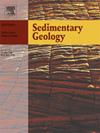Provenance of the Numidian Formation deposits (Oligo-Miocene) in northern Algeria: Insights from sandstone petrography, palaeocurrent data, geochemistry, and zircon geochronology
IF 2.9
2区 地球科学
Q1 GEOLOGY
引用次数: 0
Abstract
The provenance of the Numidian Formation deposits remains a matter of debate as to whether the source rock of the detrital material that fed the Maghrebian Flysch Basin is of European or African origin. The Numidian Formation is built mostly of Oligocene to Miocene deep-sea turbiditic sandstones and mudstones, which are widely exposed across the Mediterranean (Italy, Tunisia, Algeria, and Morocco). This study applies, for the first time, an integrated provenance analysis of the Numidian Formation in Algeria, combining detrital zircon U![]() Pb geochronology, sandstone petrography, geochemistry, and palaeocurrent orientation to constrain their source rock. Palaeoflow analysis, based on flute and groove casts indicates a predominant flow direction from the southeast to the northwest. Petrographic data show that most samples consist of quartz-arenitic sandstones, derived from igneous and metamorphic rocks. These sandstones exhibit evidence of prolonged transport and sedimentary recycling sediments, characterized by a predominance of rounded to well-rounded grains associated with a minor proportion of subangular grains. Trace elements and REE patterns suggest a felsic-intermediate source, while certain samples indicate intermediate mafic rocks and varying degrees of weathering.
Pb geochronology, sandstone petrography, geochemistry, and palaeocurrent orientation to constrain their source rock. Palaeoflow analysis, based on flute and groove casts indicates a predominant flow direction from the southeast to the northwest. Petrographic data show that most samples consist of quartz-arenitic sandstones, derived from igneous and metamorphic rocks. These sandstones exhibit evidence of prolonged transport and sedimentary recycling sediments, characterized by a predominance of rounded to well-rounded grains associated with a minor proportion of subangular grains. Trace elements and REE patterns suggest a felsic-intermediate source, while certain samples indicate intermediate mafic rocks and varying degrees of weathering.
Tectonic analysis suggests a passive continental margin setting, though some samples show evidence of a continental island arc influence. U![]() Pb geochronology conducted on 205 zircon grains yielded three main age groups: (1) Neoproterozoic (980–549 Ma, 24 %); (2) Mesoproterozoic (1527–1000 Ma, 17 %); and (3) Paleoproterozoic (2469–1636 Ma, 24 %). Additionally, a small number of younger grains (1 %) from one sample correspond to the Silurian age (436–428 Ma). Th/U ratio and cathodoluminescence (CL) images highlight the dominance of zircons with igneous origin over those of metamorphic origin. The age and morphological characteristics of zircons, along with petrographic, geochemical, and palaeoflow data, strongly support an African origin for the studied deposits. Their polycyclic nature suggests they were reworked from older sources, including the Continental Intercalaire, Nubian Sandstones, and Cambro-Ordovician sandstones found in southern Libya and Algeria.
Pb geochronology conducted on 205 zircon grains yielded three main age groups: (1) Neoproterozoic (980–549 Ma, 24 %); (2) Mesoproterozoic (1527–1000 Ma, 17 %); and (3) Paleoproterozoic (2469–1636 Ma, 24 %). Additionally, a small number of younger grains (1 %) from one sample correspond to the Silurian age (436–428 Ma). Th/U ratio and cathodoluminescence (CL) images highlight the dominance of zircons with igneous origin over those of metamorphic origin. The age and morphological characteristics of zircons, along with petrographic, geochemical, and palaeoflow data, strongly support an African origin for the studied deposits. Their polycyclic nature suggests they were reworked from older sources, including the Continental Intercalaire, Nubian Sandstones, and Cambro-Ordovician sandstones found in southern Libya and Algeria.
阿尔及利亚北部努米迪亚组沉积(渐新世-中新世)的物源:来自砂岩岩石学、古流学数据、地球化学和锆石年代学的见解
努米迪亚地层沉积物的来源仍然是一个有争议的问题,即为马格里布弗莱施盆地提供碎屑物质的源岩是来自欧洲还是非洲。努米底亚组主要由渐新世至中新世的深海浊积砂岩和泥岩组成,广泛暴露于地中海(意大利、突尼斯、阿尔及利亚和摩洛哥)。本文首次对阿尔及利亚努米迪亚组进行了物源分析,结合碎屑锆石UPb年代学、砂岩岩石学、地球化学和古流取向对其烃源岩进行了约束。古流分析表明,古流方向以东南向西北为主。岩石学数据表明,大多数样品由石英-砂质砂岩组成,来自火成岩和变质岩。这些砂岩表现出长期搬运和沉积再循环沉积的证据,其特点是以圆形至圆角颗粒为主,亚角颗粒占少数。微量元素和稀土元素模式显示其为长质-中等来源,而部分样品显示为中等基性岩石和不同程度的风化。构造分析表明一个被动大陆边缘环境,尽管一些样品显示大陆岛弧影响的证据。205颗锆石的UPb年代学结果表明:(1)新元古代(980 ~ 549 Ma,占24%);(2)中元古代(1527 ~ 1000 Ma, 17%);(3)古元古代(2469 ~ 1636 Ma, 24%)。此外,一个样品中有少量较年轻的颗粒(1%)对应志留纪时代(436-428 Ma)。Th/U比值和阴极发光(CL)图像显示火成岩锆石的优势大于变质锆石。锆石的年龄和形态特征,以及岩石学、地球化学和古流体数据,有力地支持了研究矿床的非洲起源。它们的多旋回性质表明,它们是由更古老的来源重新加工而成的,包括大陆间卡莱尔砂岩、努比亚砂岩以及在利比亚南部和阿尔及利亚发现的寒武纪-奥陶纪砂岩。
本文章由计算机程序翻译,如有差异,请以英文原文为准。
求助全文
约1分钟内获得全文
求助全文
来源期刊

Sedimentary Geology
地学-地质学
CiteScore
5.10
自引率
7.10%
发文量
133
审稿时长
32 days
期刊介绍:
Sedimentary Geology is a journal that rapidly publishes high quality, original research and review papers that cover all aspects of sediments and sedimentary rocks at all spatial and temporal scales. Submitted papers must make a significant contribution to the field of study and must place the research in a broad context, so that it is of interest to the diverse, international readership of the journal. Papers that are largely descriptive in nature, of limited scope or local geographical significance, or based on limited data will not be considered for publication.
 求助内容:
求助内容: 应助结果提醒方式:
应助结果提醒方式:


